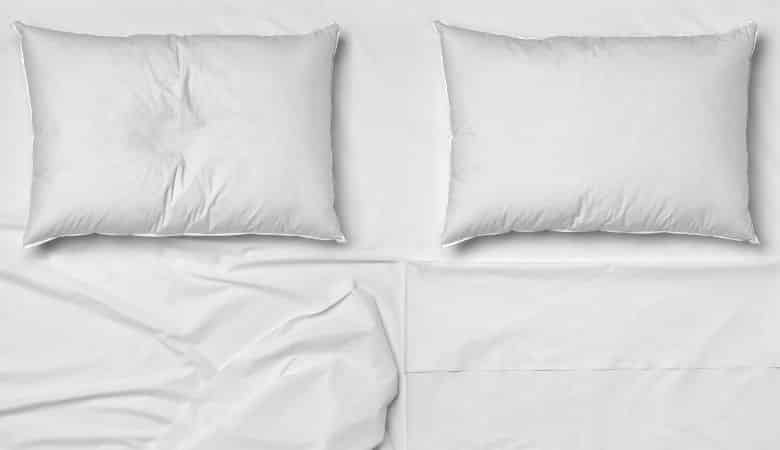This post is part of the complete guide for picking the right sleeping pillow
Sleep is an essential activity in human existence. As humans, we need to sleep to grow and to be able to carry out our daily activities.
Scientists recommend that the average human should get at least 8-hours of sleep per day to stay healthy. This is true especially when one considers the side effects of inadequate sleep some of which include heart attack, heart failure, poor motor skills, attention problems amongst others.
Seeing the importance of sleep, the human race has over time invented ways by which we can enjoy sleeping better. One of the tools developed to ensure that humans sleep better is the pillow.
The main reason why we sleep on pillows is because they help us keep our upper spine in a natural and healthy position. Pillows also help us sleep better by reducing our will to turn and toss around during the night. Finally, having something to hug, such as a pillow, has a calming effect which can lead to better sleep.
In this article, we will be taking a very close look at the reasons why humans sleep on pillows. This article contains expert opinions about the relationship between pillows, sleeping, and human health.

Why do we Sleep on Pillows?
The University of Rochester medical center researched whether humans need to use pillows, and the answer was yes. They also discovered several reasons for why humans need to make use of pillows while sleeping.
And these are:
1. Pillows help provide healthy spine alignment
The human spine is curved naturally and a pillow is required to create some sort of balance in this curvation as we sleep. Good spine alignment which is provided by pillows is important to the overall health of humans. Imagine sleeping for 8-10 hours while your spine is stressed.
Not only is a neutrally aligned spine healthy in and of itself, it’s also a comfortable position for us which helps us relax and in doing so also sleep better.
The type of mattress you sleep on matters a lot for your lower spine, but a pillow is essential to take care of your upper spine.

2. Pillows help reduce turning, twisting and tossing
Sleeping on pillows also improves comfort which helps reduce turning, twisting, and tossing on the bed. A lot of people struggle with sleeping the moment they lay down on their bed and turning and tossing contributed to that.
Scientists have proven that when your body isn’t comfortable, you’ll become restless and that will likely steal some hours of sleep away. One step in preventing this, is to use a pillow and sleep in a good sleep position.
3. Pillows provide the luxury of hugging and cuddling
Sleeping with a pillow also gives you the luxury of hugging and cuddling. Holding onto a pillow while trying to sleep can help you fall asleep faster and to help you sleep longer. It does this by giving you the same chemical reactions as hugging another person would. It also helps you stay warm on cold days.

The Origin of Pillows
The true origin of pillows cannot be pinpointed. What’s clear however is as mentioned earlier, that prehistoric animals used themselves as pillows. So, it seems that animals of all times has seeked something to put their head on as they sleep.
What is known as a pillow has changed over the years and before the current universal bed pillow, there have been different types in different parts of the world. For instance, in ancient Egypt, wooden pillows were used and they were reserved for the wealthy and the influential.

On the other hand, in Europe, softer and larger pillows made out of stuffed feathers were used. They served a wider range of use in Europe as they were also used to sit, lay and kneel.
From resting on one hand, to building head platforms with various materials, to what is known as pillows today, it is safe to say that pillows are here to stay.
Today, pillows are universal and can be found almost everywhere. Pillows are made of filler materials that are enclosed in fabric or any thick cloth material. The filler material in pillows varies and the fabric used to cover them can also be different from one another.
Aside from the upper body, putting a pillow in between your legs while sleeping also has its health benefits. It can help you to reduce the stress on your hips, relieve you of your back pains, and eliminate pressure around that area. The elevation of a part of your body with a pillow can also improve blood circulation in the lower part of your body.
Picking The Right Pillow For Sleep: A complete guide – Parts:
1. Why do we Sleep on Pillows? Here’s what research says
2. Pillow Stuffing Types: Pros and Cons of All Common Materials
3. Do You Need a Soft or Firm Pillow? A physiotherapist weighs in
4. How High Should Your Pillow Be? Ideal height for your sleeping position
5. What is The Healthiest Pillow to Use? Based on science
6. When to Replace Your Pillow? Average lifespan of all pillow types
7. How to Recycle Your Pillow? 12 things you can do with an old pillow
8. How Much Do Pillows Cost? Average price of all pillow types
9. The 9 Best Affordable Pillows For All Sleeping Positions
